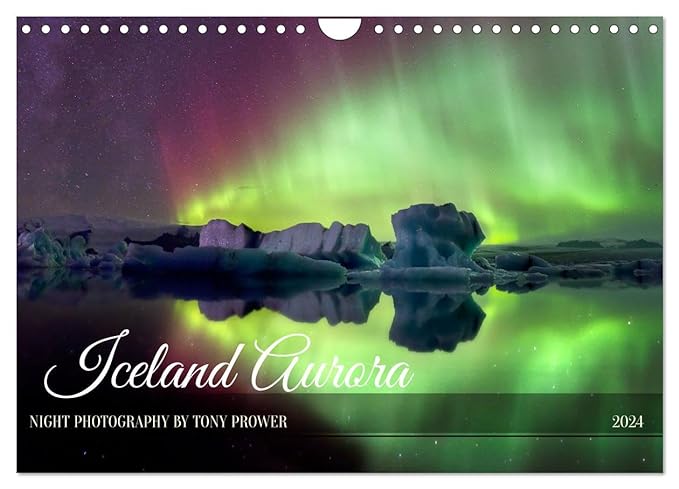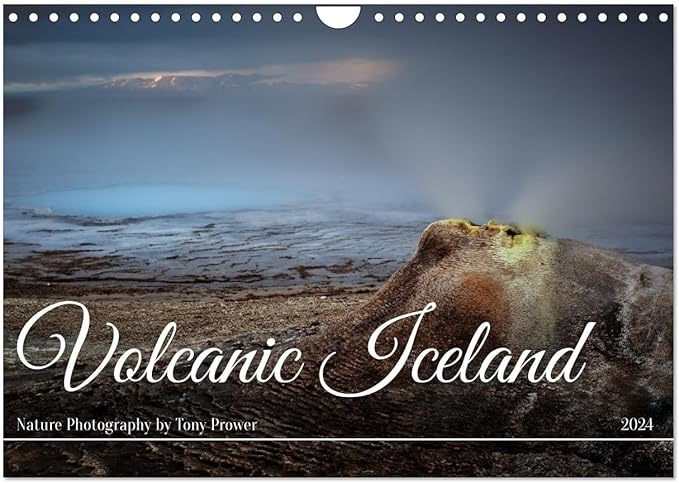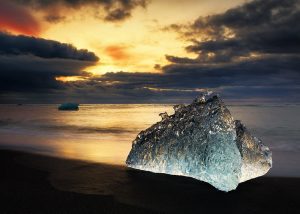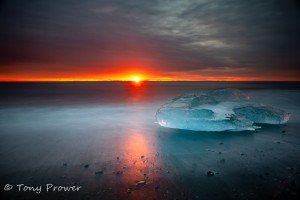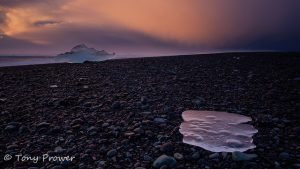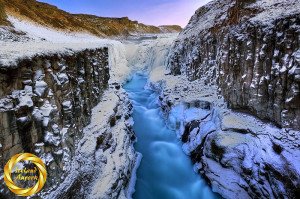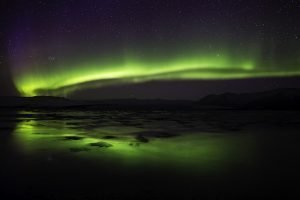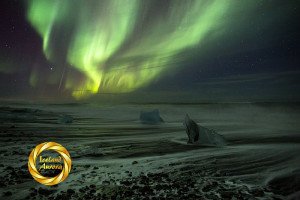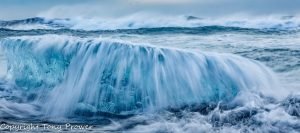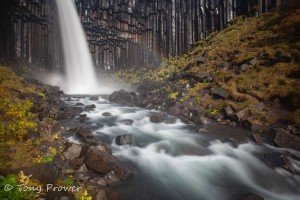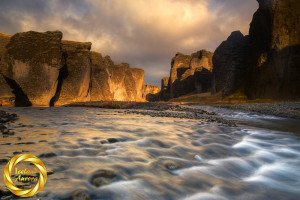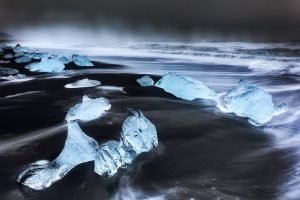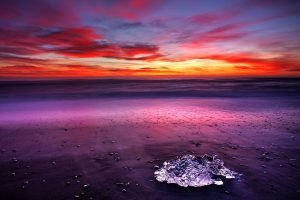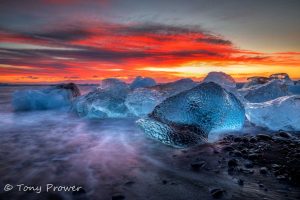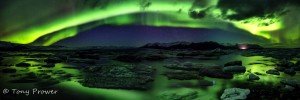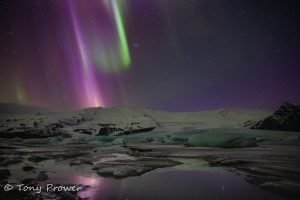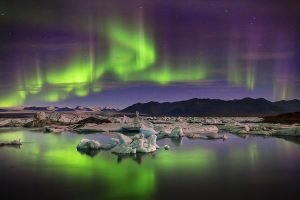Northern Lights Beginner’s Guide
Iceland’s incredible Aurora Borealis light shows are out of this world and leave you with the feeling of being on another planet. The Northern Lights are formed by the burning of atmospheric gases high above the earth as a result of solar winds from the sun. You stand on this planet and realize how small and insignificant we really are, how short our lives are, and how beautiful nature is. Northern Lights photography will create stunning pictures for your portfolio, so investing in the right gear and the right trips can reap exciting rewards.
Photographing Auroras successfully means learning some Night Photography basics, but once you have it, it becomes as easy as taking any regular photograph. Northern Lights photography is so much about being in the right place at the right time. Not many people live in good Aurora Borealis zones, so it often means travel for many people. Browse through our selection of Iceland Nature tours for plenty of great opportunities to photograph the Northern Lights in Iceland.
Camera Gear
This article discusses the use of digital SLRs (DSRLs) or modern mirror-less bridge cameras, but a film camera is equally good and, in some respects, better. Whatever your camera, you need the ability to open the shutter for at least 10-30 seconds. If you have a bulb setting (B) and a shutter release cable, then you will have much more control. I have seen people use a two-second exposure on a compact camera, and they got a result, but not the kind of result we are going to try and achieve. For good control, choose a DSLR with good high ISO settings, such as the Canon 5D or Nikon D850. This is more about dates than makes. The powerful sensors that are good for night photography started appearing on high-end cameras around 2010 and got much better again around 2014 and slightly better again in 2016. Choose a full-frame camera to get the most from a wide-angle lens.
Sturdy Tripod
Next, you will need a tripod or a way of keeping the camera perfectly still for long periods of time. I once forgot my tripod head and successfully shot with my camera resting on my camera bag. Choose a tripod carefully—not too heavy, but not too light. You don’t want to struggle carrying it over icy landscapes, and you don’t want the wind to be able to jog the camera. Try to choose one where it is easy to set up with your gloves on. You certainly don’t want to be handling bare metal without gloves in Arctic conditions.
A spare battery is very important. The cold zaps your battery, and on average, your battery life will be cut in half. In cold climates, I would recommend not using a battery pack because this keeps your spare battery out in the cold with little insulation. It is far better to have one battery in the camera and one battery in an inside pocket, so it keeps warm with you. When you swap your dead one over, you could restore some life by warming the dead battery. Remember to take plenty of memory or film; it is not nice to run out.
Private Northern Lights Tours
Wide-Angle Lens
A good lens is important. If you can choose your lens, go for a fairly wide angle (16mm – 24mm) and one with a large aperture of f/2.8 is preferable. I always manage to capture a decent amount of the display with a 24mm on a full frame, but sometimes I wish I had a wider. 17mm is easily wide enough to capture a big light show without too much distortion of the landscape.
For successful Northern Lights photography, the sky is going to be a major part of your image. Use a focal length that will allow the shape of the Northern Lights to dominate the frame. I have usually managed with my Canon 24mm prime lens, but sometimes I wish I had something wider, such as the Canon EF 16-35mm f/2.8L III USM because the Aurora can really fill the whole sky sometimes.
Photography Skills
Aurora Composition
Composing at night can be challenging, especially if this is your first time photographing the Aurora. Because it covers such a large part of the sky and can move around, photographers might pay very little attention to the landscape and their composition. While having some green on your sensor might be a priority,
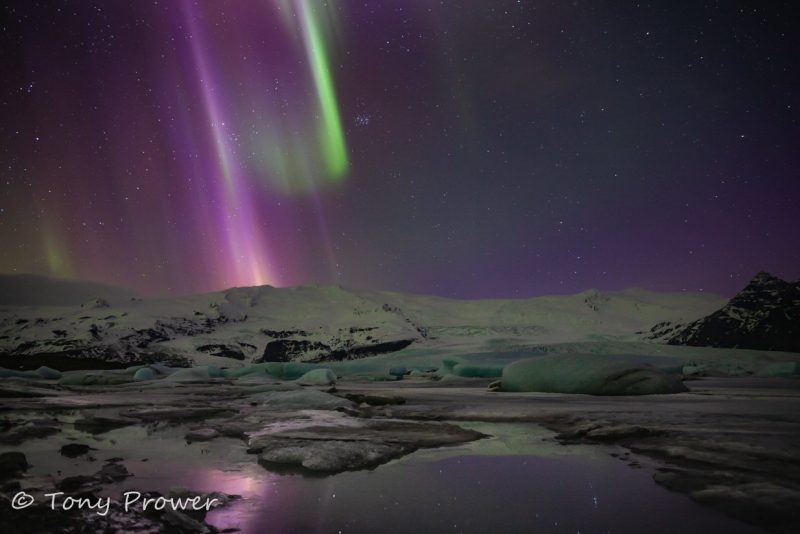
Often, the shape of the aurora will determine your composition; for example, when the light streaks straight up, you have to capture some vertical frames. It is perfectly sufficient to follow some of the basic rules of composition while you are following the Northern Lights around the sky.
Carefully composing some of the land will help give your image a sense of perspective. Favourites of mine are perfectly still water… This can be rare in Iceland, but a reflection shot is a real prize winner. If it is very dark, then look for some interesting shapes on the horizon.
You might have to wait a while for the lights to appear, but if you spend this time taking some long-night landscapes, you will have a better idea of composition when they arrive.
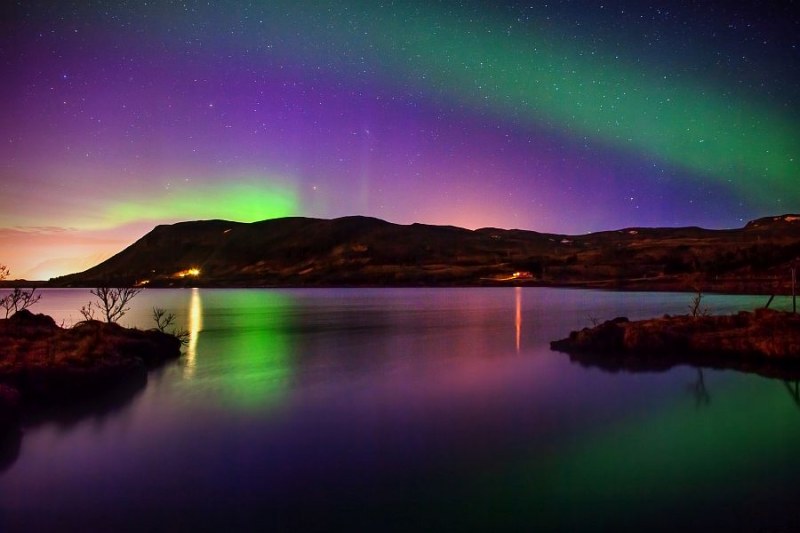
Having the right focal length is an important part of composition, and being able to include a large part of the sky plus some interest in the landscape will serve you well. The aurora might be in a different part of the sky when you find a decent composition, but remembering the composition for future reference can be beneficial if the Northern Lights position changes again.
With a wide-angle lens, I might use the rule of thirds to capture a third landscape and a two-thirds sky. If there is a great reflection, I might put the horizon dead centre and shoot with the rule of symmetry.
HDR Northern lights Photography
Go for it if you have the patience. The image above was taken from two exposures: 30 seconds to capture the sky and 6 minutes to capture the foreground.
The downside is that you will miss out on a lot of Northern Lights exposures while you are exposing your foreground shot. For post-processing, it is best to bring the original sky back into the image for natural-looking stars (see comment below).
Magic Cloth Technique
You can apply the Magic Cloth Technique in a similar way. As soon as you know the right exposure for the sky, just cover the sky and allow another three times the exposure for the landscape. More info here:
Tony’s Magic Cloth Technique This has the same downside: you will miss shots while exposing the foreground, but because it is a single exposure, you do save a bit of time over the HDR 2 exposure method
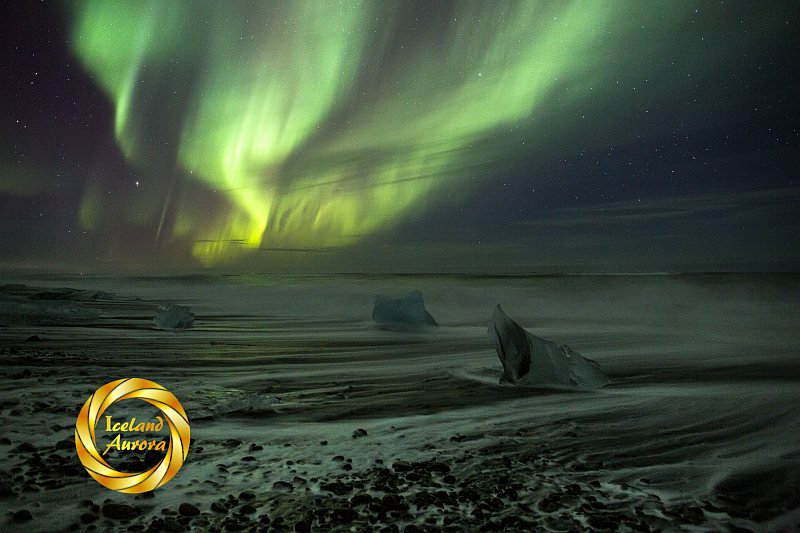
Northern Lights Exposure Guide
If you have perfect weather and all the equipment, what do you do next? If you have a digital camera, you can take many exposures and judge from the perspective of your viewer. Use these exposure times as a rough guide. They will give you a result in most Aurora conditions. Then adjust accordingly. I don’t believe there are any set rules for which aspect to adjust.
The following exposure guide should be used if you can clearly see the northern lights with the naked eye. Double these values if the aurora can’t be seen, and try the adjustments mentioned below to fine-tune your northern lights exposure.
Aurora Exposure Chart
| F stop | iso 800 | iso 1600 |
| f/1.4 | 4 sec | 2 sec |
| f/2 | 6 sec | 3 sec |
| f/2.8 | 12 sec | 6 sec |
| f/4 | 20 sec | 10 sec |
If the photos are too bright:
- Reduce the exposure time – this will give you better stars
- Reduce the iso – this will give you better quality
- Smaller Aperture – this will give you better sharpness
If the photos are too dark:
- Increase exposure time – risk getting star trails
- Increase iso – this might reduce quality
- Larger aperture – may introduce Coma (stars have a weird shape in the corners)
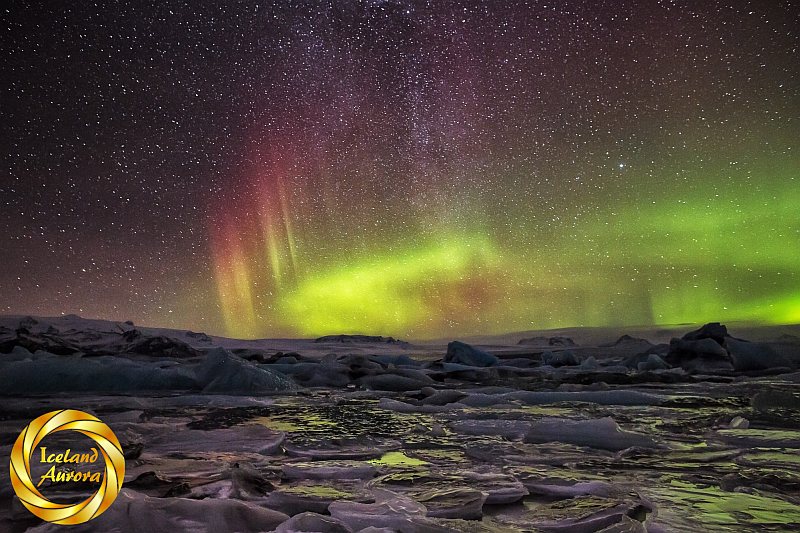
Aurora Conditions
The second consideration is the weather. If you are far north enough to see them, then you will probably have very changeable weather. The ideal conditions are very very clear skies. The moon plays an important role. It is a matter of taste, but I prefer not to have the moon in the shot. Having the moon behind you can really help to expose the landscape, but a full moon makes your shot look like a day time photograph. This is enhanced further if the landscape is covered in snow. The wind can be a challenge… the less wind, the better.
The most important weather consideration is space weather and you can check the Northern Lights Forecast on Live Aurora Map If this site says it is good, then it will be good. The thing to look for (if you can’t see anything yet) is a feint green streak across the sky, this is a good sign that it is worth waiting around for an hour or so.
How high in the sky are the Northern Lights?
All that energy is going on 70-90 KM up where atomic gas particles glow.
When is the best time to see Auroras?
In Iceland, Northern lights can be seen from the end of August to the beginning of April. It is impossible to see them in the Icelandic Summer because the sky is too bright. During the Winter months the Northern lights can appear at anytime that it is dark. The strongest Northern light shows are usually between 10PM and 2AM.
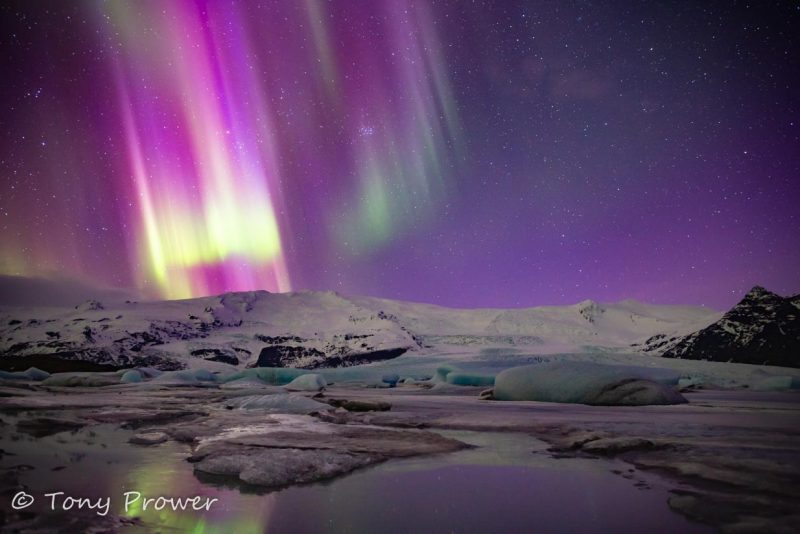
Moon Phases
Photographing Northern Lights is possible during all moon phases. The moon is a source of light pollution which means that the sky wont be properly dark with a full moon. A successful aurora picture would require a very strong aurora display. Most pictures in anything more than a half moon will capture only green auroras because it is not dark enough to define the other colours. A half moon in the opposite sky to the Norther lights can be useful to expose the foreground without any tricks. A new moon is difficult to expose and process but gives a much fuller spectrum of Northern Lights colour.
- Very dark moonless night meant using higher iso and destructive processing, but the colours are rare.
- A half moon was useful to light up the glacier ice. The colours are mostly green with hints of red.
Earth Weather
The perfect Northern lights weather is zero clouds although a few clouds can help to add depth to the photo. The trouble is that clouds love Iceland. It rains every other day here. If it is raining, the chances of seeing Northern lights are very slim because rain clouds are very deep and this also means very big. If you go out in the rain, you could get a window in the clouds which could let you see the aurora, but going out expecting this is close to madness.
Wind is fine, but you have to be careful with your camera tripod because it is not fun when that blows over. A steady camera is crucial for a successful long exposure.The trouble with Arctic winds is that it feels 10 degrees colder. The other problem with severe weather is that it makes travel very difficult. Those clear skies can bring black ice conditions. Even a careful driver can get into a mess very quickly and especially an in-experienced driver with a large 4X4 who is not used to Winter Driving.
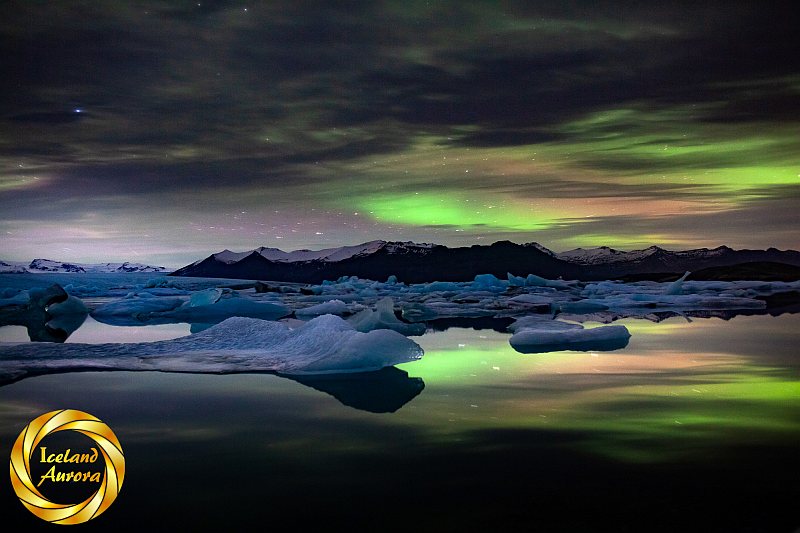
If you already know how to control your camera at night, you can get great Aurora photos on a Northern lights tour in Iceland.Northern Lights Tours
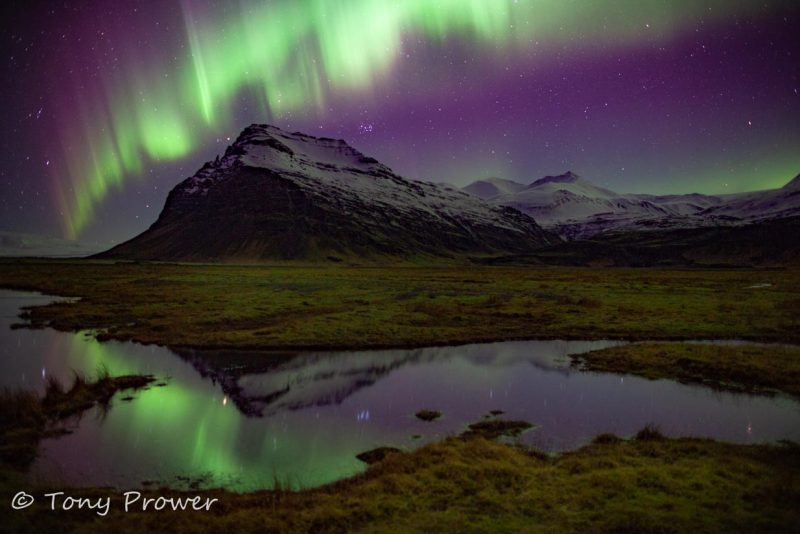
Sponsored
Create your own website
Are you thinking of building your own photo website? There are so many tools to help photographers display and sell their photos online. Having your own website is like owning a property, you don’t have to pay commission to third party online galleries Siteground are the best webhosts I have used in my 15 years of running icelandaurora. They are currently having a sale.

Aurora Forecast links
Forecasting the Northern lights has become as accurate as forecasting Earth weather. The more sophisticated tools that scientists use to observe the Sun’s activity give us valuable warnings about sun spots and approaching solar flares. The Northern lights forecast is the first thing we check if clear skies on earth look likely. It s useful to be able to check the real-time aurora activity as well as the Northern lights forecast.
Iceland
International
Aurora Facts
Aurora Colours
The colours of the Aurora Borealis are a geomagnetic phenomenon that occurs as a result of solar energy from the sun entering earth’s outer atmosphere. Electrons collide with different gases in the atmosphere to give a range of different colours. Oxygen emits a green/yellow colour during this violent energy event. Reds, Blues and violets are caused by Nitrogen (the most abundant gas) although the colour depends if it is atomic or particle nitrogen.
Superstition
The vikings believed that the dancing lights were the souls of the war-dead on their journey to Valhalla. Many other cultures have seen them as omens of war. In medieval Iceland, a pregnant woman was not allowed to whistle for fear of being whisked away by the lights. In nearby Greenland, the aurora was thought to be a giant walrus in the sky.

Can you photograph the Northern Lights from a boat?
You can photograph the Northern lights from a moving car, so long as you are travelling in a straight line and keep the camera pointed in the same direction. The landscape will be a blur and there will be no stars, but the aurora will be in your photo. I have seen one photo from a ship with good stars and this was taken with a tripod on a very very calm ship. If the sea is rough, the tripod will at least give you a sharp boat and aurora borealis.
Electronic Music
Is it possible to hear the Northern Lights?
Yes, but it is incredibly rare. The sound is like someone gently folding tinfoil, but the experience is everywhere overhead. Maybe more like an electronic round of applause in a heavenly auditorium. It was thought that the sound was coming from pine needles popping in the highly charged air, but Finnish scientists have recently found that the sound is coming from 70 miles above the pine trees. Charged particles that are trapped in an atmospheric layer are released with a pop when the are hit by strong surges of electron from the sun’s surface.
Iceland Locations
On a still, clear night with no clouds and big icebergs, Jokusarlon Glacier lagoon is not only the best place in Iceland to experience the heavenly light show, but the bet place in the World. Only the view from the space station could top the experience. Generally the lagoon works better than the ice beach because the electric action is in the Northern part of the sky.
Iceland’s East Cast and Westfjords can both give an uninterrupted view to the Northern Sky, if you manage to find a good coastal feature at the pinnacles of the fjords.
The Southern waterfalls could be good, it is possible to experience Northern lights at Skogafoss waterfall. Unfortunately there are 2 bright spotlights at Seljalandsfoss waterfall. This not to everyone’s taste and can ruin a long exposure.
The Goðafoss waterfall in North Iceland is a rare, but worthwhile experience. Travelling to North Iceland in the Winter can be a challenge with chances of getting stranded. If you do get there on a clear night, be on the East side and hope that the light show extends to the West.
The world famous Kirkjufell Mountain is a superb location in West Iceland. Including the Kirkjufellsfoss waterfall can create a very dynamic night landscape photo.





